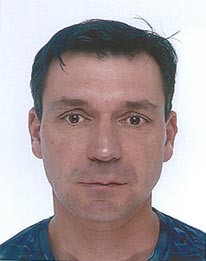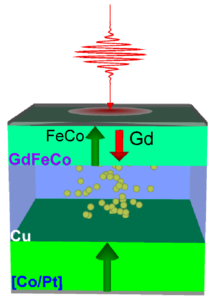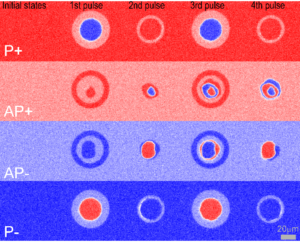 On January 29, we have the pleasure to welcome Stephane Mangin from Institut Jean Lamour, Univ. de Lorraine, Nancy, France. He will give us a seminar at 11:00, CEA/Spintec, Bat. 1005, room 434A entitled :
On January 29, we have the pleasure to welcome Stephane Mangin from Institut Jean Lamour, Univ. de Lorraine, Nancy, France. He will give us a seminar at 11:00, CEA/Spintec, Bat. 1005, room 434A entitled :
All-optical magnetization switching in spin-valve structure mediated by spin-polarized hot electron transport
S. Iihama1,2, Y. Xu1, M. Deb1, G. Malinowski1, M. Hehn1, J. Gorchon1, E. E. Fullerton1,3, and S. Mangin1
All-optical switching (AOS) without any magnetic field has a great potential for the future ultrafast and energy efficient magnetic memories. It was firstly demonstrated that the magnetization of a GdFeCo ferrimagnetic film can be

Figure 1 Schematic illustration of AOS in GdFeCo / Cu / [Co/Pt] spin valve structure.

Figure 2 MOKE images after irradiation of single fs-laser pulses for GdFeCo (5) / Cu (9.3) / [Co/Pt]4 spin-valve structure with different four initial magnetic configurations.
engineer magnetic materials for the ultrafast and energy efficient all-optical magnetic recording.
[1] I. Radu et al. Nature 472, 207 (2011)
[2] T. A. Ostler et al. Nat. Commun. 3, 666 (2012)
[3] S. Mangin et al. Nat. Mater. 13, 286 (2014)
[4] C. -H. Lambert et al. Science 345, 1337 (2014)
[5] M. S. El Hadri et al. Phys. Rev. B 94, 064412 (2016)
[6] J. Gorchon et al. Appl. Phys. Lett. 111, 042401 (2017)
[7] G. Malinowski et al. Nat. Phys. 4, 855 (2008)
[8] D. Rudolf et al. Nat. Commun. 3, 1037 (2012)
[9] A. J. Schellekens et al. Nat. Commun. 5, 4333 (2014)
[10] S. Iihama et al. arXiv : 1805.02432
1 Institut Jean Lamour, UMR CNRS 7198, Université de Lorraine, France
2 WPI Advanced Institute for Materials Research, Tohoku University, Japan
3 Center for Memory and Recording Research, University of California San Diego, USA




